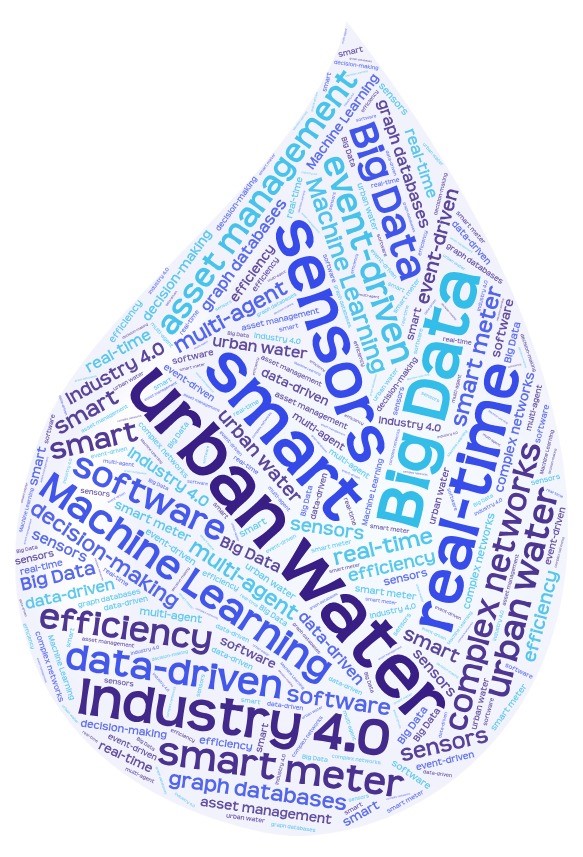
Time for a complete data-revolution in Urban Hydraulics
Posted on: November 2018Manuel Herrera
Time for a complete data-revolution in Urban Hydraulics
| About the author: Dr Manuel Herrera is a WATEF Technical Committee Member and Research Associate in Distributed Intelligent Systems at the Institute for Manufacturing at the University of Cambridge (UK). |
|
 |
I would like to acknowledge the recent WATEF blog written by Dr Kourosh Behzadian; Towards Smart Water Systems. In that blog, Kourosh goes through the ongoing technology of water distribution systems cunningly envisaging their future. This is a future of water stress due to growing cities population and climate change scenarios. This is also a future in which new technologies for sensoring and collecting data will be ubiquitous in a more than ever interconnected world. Kourosh’s blog focuses on the influence of smart metering on the efficiency, operation and management of current and future urban water systems. This result seems to me to be quite inspirational and made me think about a number of questions beyond all the current and future smart-technology available. What we can do with the huge quantity of data associated with such cyber-physical systems? How we can transform these data into knowledge? How might this data impact into further challenges on water supply management? Are we witnessing a data-revolution in Urban Hydraulics? The current blog attempts to discuss these questions and, hopefully, prompts other questions to you.
Past and present of Urban Hydroinformatics
At the turn of the 20th century, Savic and Walters [1] formalised the concept of hydroinformatics as a water-field discipline based on computational sciences and artificial intelligence. This was presented as a novel and revolutionary way to tackle water network management and maintenance. With the beginning of the 21st century, their research, (together with the rest of the group based in Exeter, UK) was recognised as pioneering in the application of soft and evolutionary computing to water distribution networks. We can say, with no doubt, they fostered the dawning of the data-revolution in Urban Hydraulics. Novel developments and uses of computational intelligence methods for design, scheduling and optimization were key for raising the new Hydroinformatics and led novel research trends.
In the early 2000s, coinciding with the consolidation of Data Mining as a new data analysis trend, a range of data-driven methods was adopted to approach several topics in Urban Hydraulics. The variety and performance of the proposed methods ranged from expert systems and neural networks to more sophisticated, combined methodologies, which extended the research panorama to where we are now. There are many advantages of embracing data-driven approaches with respect to classical models. All of them are motivated by two key factors: the increasing computing capabilities and the amount of available information. These main facts opened new paradigms on Urban Hydraulics for solving the complex, iterative equation systems that model the behaviour of large-scale water systems, by surrogating the hydraulic network performance under disruption scenarios, improving the accuracy of the current hydraulic performance models, and even proposing near real-time solutions to online water distribution system management. All of them are beyond the limits of any classical approach. Over the time, computing intelligence methodologies have evolved along with their aims and objectives in Urban Hydraulics. Top research topics during the last few years have been, therefore, diverse; ranging from water network partitioning into district metered areas to system resilience assessment and security. However, we are now seeing the start of a novel revolution for urban water that can be understood under the influence of the so-called Industry 4.0. Water distribution systems have become cyber-physical systems with sensors and smart-meters placed both at water distribution networks and homes, thus providing enormous quantities of distributed online data along the water system at several scales of management. Water companies now face the challenge of how to deal with this data which has rapidly become the 21st century’s big paradigm for Urban Hydraulics.
Time for data-revolution!
Big data, near real-time monitoring, uncertainty of asset states, and event-driven applications, all of these research topics will be essential to develop further algorithms able to deal with the inherent volume and complexity of urban water databases.
 Big data is defined in the Gartner’s IT Glossary as “high volume, high velocity, and/or high variety information assets that require new forms of processing to enable enhanced decision-making, insight discovery and process optimizationâ€. This definition is also known as the 3V’s, making reference to the three key challenges in which big data is involved: volume, velocity, and variety. Some researchers also view big data as a problem of high complexity. Big data is strongly related to the topic of Urban Computing, which analyses the high complexity, heterogeneity, and volume of data generated in urban environments. Big data issues arise from high rate data streams acquired through smart sensors and automatic metering readers. Even for small water utilities, sensors may produce a huge amount of data to be stored and further analysed. The straightforward application of computational intelligence tools is not enough anymore, and interest should focus on working with scalable algorithms, even under parallel design, for running over high performance computing clusters. This shift is also noticeable in the software that will be necessary to use from now onwards. Water management and Data Science libraries should be integrated in a common software environment also linked to big data solutions such as Hadoop or Apache Spark. The use of graph databases to manage the huge volume of data that is processed nowadays by water utilities is another promising tool that deserves further development and research. Graph databases use graph structures for semantic queries with nodes, edges and properties to represent and store data. The performance of graph databases naturally engages with both the spatially distributed customer information and the physical topology of water networks.
Big data is defined in the Gartner’s IT Glossary as “high volume, high velocity, and/or high variety information assets that require new forms of processing to enable enhanced decision-making, insight discovery and process optimizationâ€. This definition is also known as the 3V’s, making reference to the three key challenges in which big data is involved: volume, velocity, and variety. Some researchers also view big data as a problem of high complexity. Big data is strongly related to the topic of Urban Computing, which analyses the high complexity, heterogeneity, and volume of data generated in urban environments. Big data issues arise from high rate data streams acquired through smart sensors and automatic metering readers. Even for small water utilities, sensors may produce a huge amount of data to be stored and further analysed. The straightforward application of computational intelligence tools is not enough anymore, and interest should focus on working with scalable algorithms, even under parallel design, for running over high performance computing clusters. This shift is also noticeable in the software that will be necessary to use from now onwards. Water management and Data Science libraries should be integrated in a common software environment also linked to big data solutions such as Hadoop or Apache Spark. The use of graph databases to manage the huge volume of data that is processed nowadays by water utilities is another promising tool that deserves further development and research. Graph databases use graph structures for semantic queries with nodes, edges and properties to represent and store data. The performance of graph databases naturally engages with both the spatially distributed customer information and the physical topology of water networks.
Near real-time monitoring: New paradigms introduced in data management within the smart city framework mean that the model can take into consideration all the available information, and can be efficiently updated in near real-time. The new paradigm of online modelling in water distribution systems is a topic of growing interest, given the high amount of data information with which water utilities operate nowadays, aiming at making decisions in a very short time. Online predictive models for water demand forecasting have emerged to bridge the gap between this constant flow of available information and off-line models, which are not optimized to be updated in near real-time. Through online models for water demand, it is possible to improve predictions of water demand and to have better control of such system state variables as flow and pressure, by suitable valve and pump operation.
Soft computing methods for asset management: Asset management is the ensemble of processes water utilities use to make sure that planned maintenance can be conducted and capital assets (such as pumps, valves, and pipes, among others) can be repaired, replaced, or upgraded in time. The current asset attributes of age, condition, and criticality have an associated essential uncertainty regarding their complete knowledge. This opens a proper research avenue on applying soft computing methods, mostly those related to probabilistic reasoning and Bayesian analysis. Other related topics are optimal sustainable level of service, asset criticality, or minimising asset life-cycle cost. Heuristic model strategies for optimisation and ranking algorithms might be applied to meet these objectives. When subjectivity is the origin of uncertainty, multi-criteria decision-making methods could well also be used.
Event-driven applications: agent-based simulation modelling has been currently adopted as a new paradigm in many fields. Agent-based models are used to tackle complex systems. The water field is not an exception. In event-driven applications events happen and are launched along the time. Events model changes in the system. A change happens when an agent receives a message or reaches a specific location or status in the system. Using multi-agent-based models it is feasible to build digital twins of our systems. The insights such a twin system can provide to utilities will develop into full awareness of their systems. This will improve asset management and near real-time operation, what will certainly enhance forecasting capabilities, decision-making and prioritization on planning and operational optimization.
Final remark
It has been a long road from the first intelligent data analyses that approached urban water issues. After a hard start in which other engineering branches held the initiative on applying these concepts and methodologies, computational intelligence methods have settled in urban water management and their influence is growing in an exponential way. The same way in which data availability and computational power are growing, and the same way in which the Industry 4.0 brings a new generation of research. This is time for a complete data-revolution in Urban Hydroinformatics!
This is an adaptation/expansion of the work presented by Herrera et al. [2] at the Congress on Numerical Methods in Engineering, 3–5 July 2017, Valencia, Spain.
References:
[1] D. A. Savic and G. A. Walters, “Hydroinformatics, data mining and maintenance of UK water networks,†Anti-corrosion Methods and Materials, vol. 46, no. 6, pp. 415–425, 1999.
[2] M. Herrera, D. Ayala-Cabrera, J. Izquierdo and I. Montalvo. “Smart data analysis for smart water networksâ€, Congress on Numerical Methods in Engineering, 3–5 July 2017, Valencia, Spain, 2017, pp. 1665-1677.



